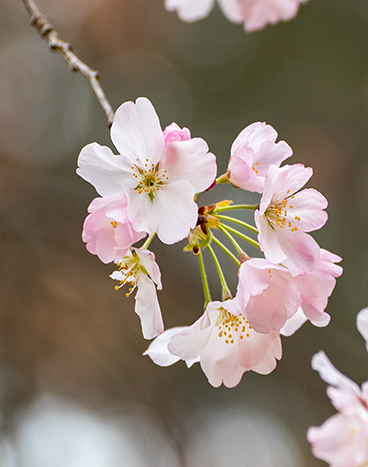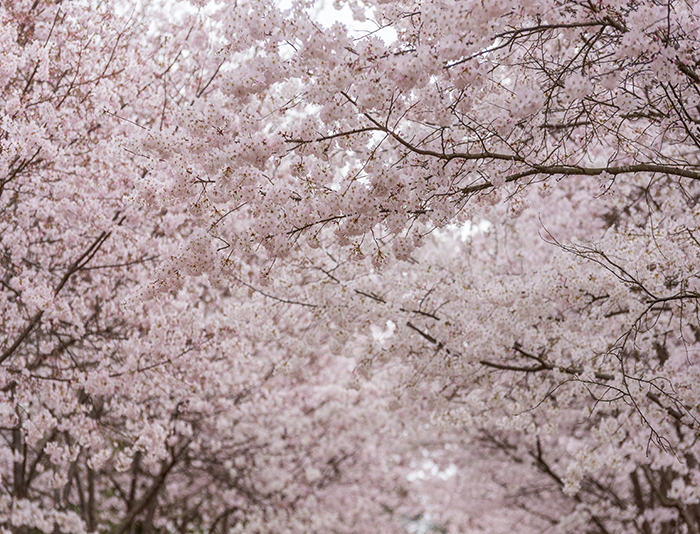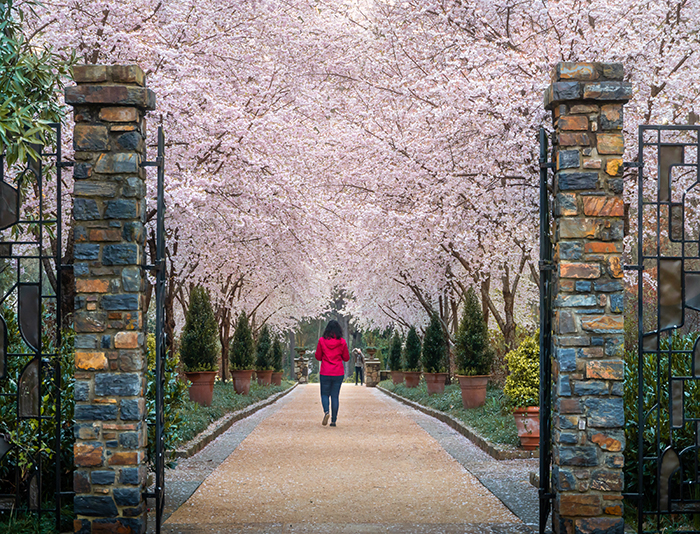Garden Talk
Horticultural Highlight: 'Daybreak' Yoshino cherry
In this series, the staff of Duke Gardens highlights plants you’ll find within our 55-acre living collection. This week, marketing and communications assistant Katherine Hale discusses the ancient spring tradition of cherry blossom viewing, and its current role at Duke Gardens.
Botanical name: Prunus × yedoensis ‘Akebono’
Common name: Daybreak Yoshino cherry
Family name: Rosaceae (Rose family)
Native range: Cultivated origin
Location in Duke Gardens: Historic Gardens, Culberson Asiatic Arboretum
USDA Hardiness Zones: 4-8

At the beginning of every calendar year, the Japanese Meterological Agency publishes the official sakura zensen, or cherry blossom front, which charts the gradual flowering of the cherry trees across the country from early March to mid-May. Prominently displayed on every major news network, these bright pink maps are provided as a public service for those eager to view the flowers at their peak—a practice known as hanami—during the all too brief window of bloom. Although dozens of different kinds of cherry trees are found in Japan, the bulk of this forecast—and all the human interest that comes with it—centers on one widely planted species in particular: the Yoshino cherry (Prunus × yedoensis).
A hybrid between between the Oshima cherry (P. speciosa) and weeping cherry (P. pendula f. ascendans), Yoshino cherry is thought to have originated in the Japanese city of Edo (now Tokyo) through artificial crossing in the early 16th century. As with other ornamental cherry trees, it is beloved for blooming before the leaves have unfolded, transforming the canopy into a sea of airy clouds for a brief period before the pink-white flowers fall. Thus, hanami becomes a celebration of the transient nature of beauty—and with such a short window, an accurate meterological forecast is extremely helpful in ensuring that one misses out.
Widely planted after World War II as a gesture of peace and friendship, Yoshino cherry trees are now found around the world, including the iconic grove around the Tidal Basin in Washington, D.C. ‘Akebono’ (‘Daybreak’ in English) is one of the most popular cultivars in the United States, so much so that in Japan it is known as ‘America’. A stately row of these mature trees welcomes visitors at Duke Gardens’ main entrance, forming a sheltered botanical avenue from the Gothic Gate to the Roney Fountain and Mary Duke Biddle Rose Garden. Others are scattered throughout the Historic Gardens and the Culberson Asiatic Arboretum.
Here at Duke Gardens, the custom of appreciating cherry blossoms is alive and well, albeit in a more limited form than in Japan. Lacking a dedicated government forecast, the staff and volunteers at the front desk must rely on their own personal observations as they field questions from eager visitors as to when the cherries will bloom each year. The exact dates vary widely due to both fluctuations in the weather and a gradual warming of the climate over time; in recent years, it has usually been around mid-March through early April. Depending on the weather conditions thereafter, they may remain for a few days or even more than a week before fluttering to the ground like snowflakes.
Though much emphasis is placed on calendars and timetables for peak bloom, cherry blossoms can be appreciated at any point in the cycle—before, during, and after flowering. Their ephemeral nature serves as a poetic reminder that perfection is only attainable for a brief moment (if that)—so why not step outside our usual ideas of time and appreciate the moment just as it is?
Photos from top to bottom: 'Daybreak' Yoshino cherry trees in the Cherry Allée at the Gothic Gate, in an archive photo by Clarence Burke; close-up of cherry blossoms and a detail of the canopy, by Cathi Bodine.







